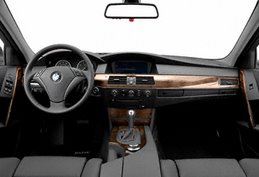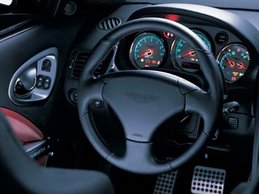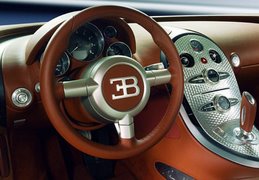 2008 BMW M3 - Our qualms were unwarranted. Although the 2008 BMW M3, which goes on sale next spring, is the absolute state of the art in engine and chassis technology, it remains the soulful driving machine that made its predecessors perennial Car and Driver 10Best favorites. And although the M3’s refined manners draw a closer comparison to Bruce Banner, there is still a monster lurking just beneath the surface. Under the bulging aluminum hood is a V-8 that makes 414 horsepower and spins to an astonishing 8400 rpm. Eight cylinders were necessary considering that the M3’s main rivals—the Audi RS 4 and the Mercedes-Benz C63 AMG—both feature V-8 power, but the M3’s engine is more than just a marketing ploy. The 4.0-liter, based on the 5.0-liter V-10 in the M5, is in fact 33 pounds lighter than the 3.2-liter inline-six from the previous M3. However, the entire car weighs about 250 more pounds than the last M3, and that’s a consequence of the 3-series coupe, the car on which the M3 is based, getting bigger. Even so, BMW has tried hard to keep the weight down and claims 80 percent of the M3’s technically relevant parts differ from the 3-series’.
2008 BMW M3 - Our qualms were unwarranted. Although the 2008 BMW M3, which goes on sale next spring, is the absolute state of the art in engine and chassis technology, it remains the soulful driving machine that made its predecessors perennial Car and Driver 10Best favorites. And although the M3’s refined manners draw a closer comparison to Bruce Banner, there is still a monster lurking just beneath the surface. Under the bulging aluminum hood is a V-8 that makes 414 horsepower and spins to an astonishing 8400 rpm. Eight cylinders were necessary considering that the M3’s main rivals—the Audi RS 4 and the Mercedes-Benz C63 AMG—both feature V-8 power, but the M3’s engine is more than just a marketing ploy. The 4.0-liter, based on the 5.0-liter V-10 in the M5, is in fact 33 pounds lighter than the 3.2-liter inline-six from the previous M3. However, the entire car weighs about 250 more pounds than the last M3, and that’s a consequence of the 3-series coupe, the car on which the M3 is based, getting bigger. Even so, BMW has tried hard to keep the weight down and claims 80 percent of the M3’s technically relevant parts differ from the 3-series’.The M3’s interior has undergone fewer alterations than the exterior, but there are a number of significant
 changes. The usual M treatment includes sportier seats with deep torso and side bolsters, a thick leather steering wheel, and a new M-badged tachometer. The iDrive knob is present, and aside from our usual gripe about its lack of user-friendliness, we mention it because it accesses the settings for M Drive. As in the M5 and M6, the M Drive button on the steering wheel switches the car into a sport mode that can be customized via the iDrive wheel. There are four systems: throttle sensitivity, variable shock absorbers (optional), stability control, and power-steering assist. Throttle control and steering can be set at normal or sport, the latter giving quicker reactions to the gas pedal and producing a heavier steering feel, respectively.
changes. The usual M treatment includes sportier seats with deep torso and side bolsters, a thick leather steering wheel, and a new M-badged tachometer. The iDrive knob is present, and aside from our usual gripe about its lack of user-friendliness, we mention it because it accesses the settings for M Drive. As in the M5 and M6, the M Drive button on the steering wheel switches the car into a sport mode that can be customized via the iDrive wheel. There are four systems: throttle sensitivity, variable shock absorbers (optional), stability control, and power-steering assist. Throttle control and steering can be set at normal or sport, the latter giving quicker reactions to the gas pedal and producing a heavier steering feel, respectively.BMW’s fetish for technological overkill is not limited to M Drive, but the rest of the gadgets are far more useful. The rear differential lock, aptly called “M variable differential lock,” adjusts the locking ratio based on the speed difference between the rear wheels. The alternator cycles off when the engine is under load and engages during braking or coasting. The payoff is more power and better fuel efficiency.
The irritating starting procedure from the 3-series has not been improved in the M3, but once we got the key fob in its slot, depressed the clutch, and engaged the start button, we got over it. The V-8 roared to life, and we were delighted to see a conventional do-it-yourself six-speed, which is the only setup.

There’s a temptation to rev the ever-loving stuffing out of the engine as soon as it’s fired up, but the sliding redline indicator on the tachometer encourages more adult behavior—at least until the engine warms up and all 8400 revs are available. Even though the horsepower peaks just below the maximum engine speed, the M3’s engine has usable thrust throughout its entire range. The torque peak of 295 pound-feet comes at 3900 rpm, but the torque curve is nearly flat from 3500 to 6500 rpm. There’s enough low-end grunt that it’s easy to forget how much the engine can be wrung out. It’s almost natural to shift before the redline because, well, most V-8s would destroy themselves at that high an engine speed.













No comments:
Post a Comment